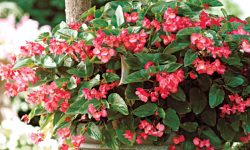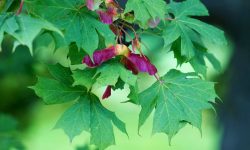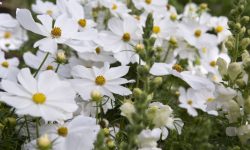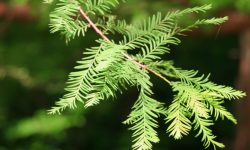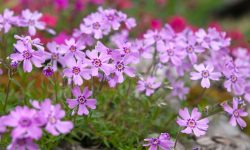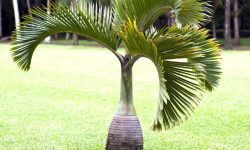Yellow wildflowers, main draws for bees and other pollinators, flourish abundantly throughout North America. Thriving in diverse habitats, from desert scrub to California’s chaparral, and from prairies to woodlands, they enrich the landscape. Alongside native species, introduced yellow wildflowers further diversify the floral tapestry. Explore some of the most common species found across North America and beyond.
Different Types of Yellow Wildflowers
Wingstem
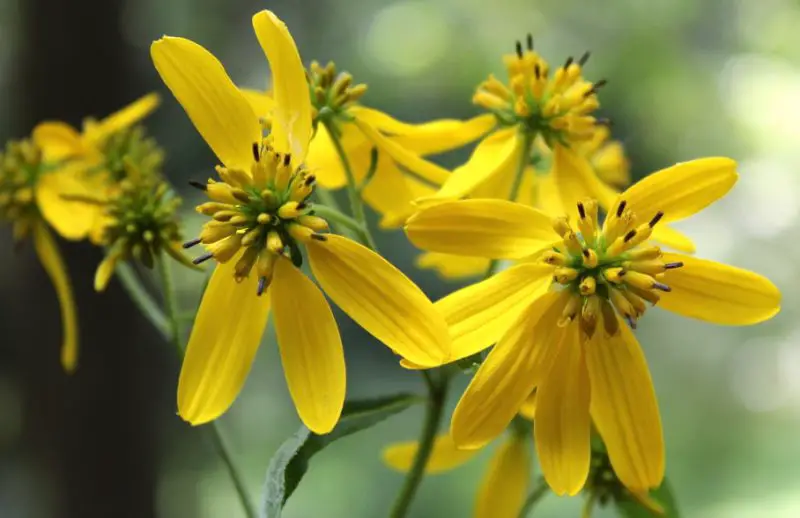
The Aster family plant Wingstem (Verbesina alternifolia), popularly referred to as the Yellow Ironweed, has several tiny yellow flowers. It supports a variety of species, including Gracillariid moth caterpillars and gold moths, making it essential to moth ecosystems. Climbing to a maximum height of 8 feet, every stem carries clusters of up to 10 yellow blooms that are spread by wind or birdseed. The blossoms are dry seed pods.
Straggler Daisy
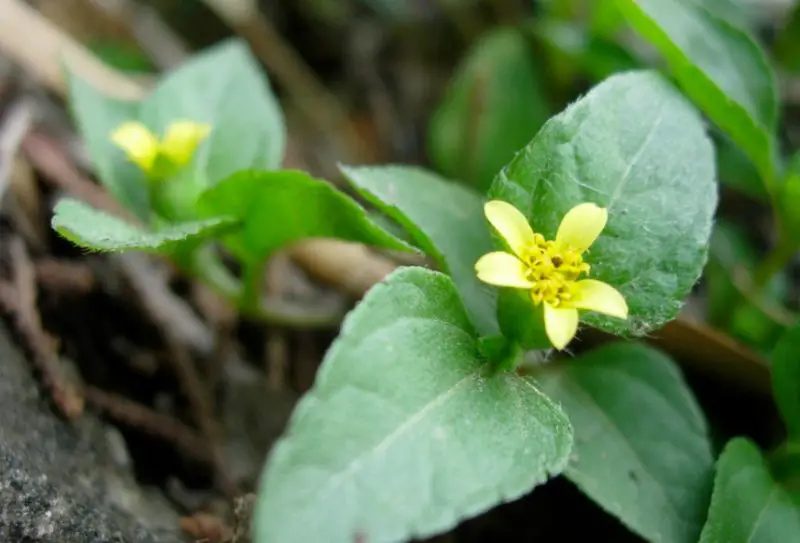
The little yellow flowers of the traggler daisy (Calyptocarpus vialis) are highly valued and perfect for gardening. Growing best in damp conditions, it needs to be managed carefully to avoid overpopulation and uncontrolled spread. By using containers, you can extend the bloom season from spring to late summer and reduce these concerns.
Common Toadflax
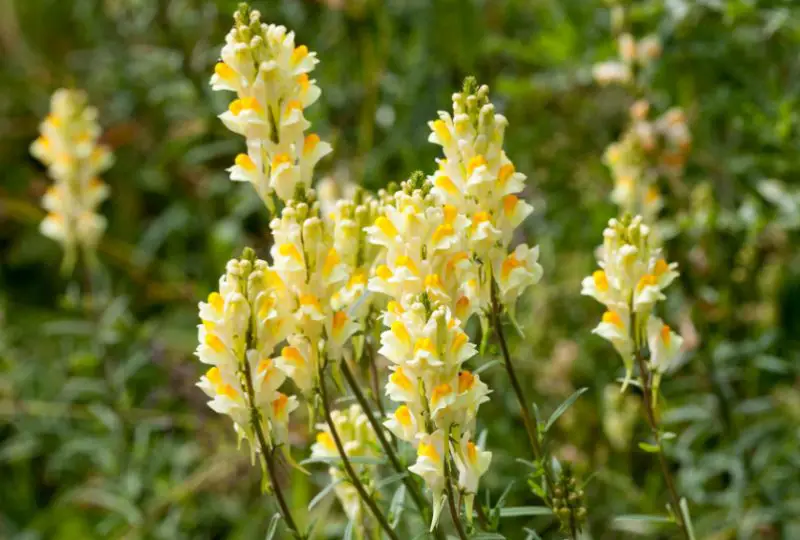
The common toadflax, or Linaria vulgaris, is cherished for its ecological significance and for its eye-catching yellow and orange blossoms that are displayed. It draws frequent visits from bumblebees, which use it as a host for caterpillars and an essential food source for bees, moths, and butterflies. It was brought to North America and can grow up to 35 inches in height.
Deerweed

A essential component of California’s environment, deerweed (Acmispon glaber) boasts countless tiny blooms from San Diego to San Francisco. It can reach a height of three feet and is highly valued for its quick development and capacity to flourish in low-moisture soils, which makes it a well-liked option for gardens. Orange Sulphurs and other lovely butterflies are drawn to its vivid blossoms.
Bermuda Buttercup
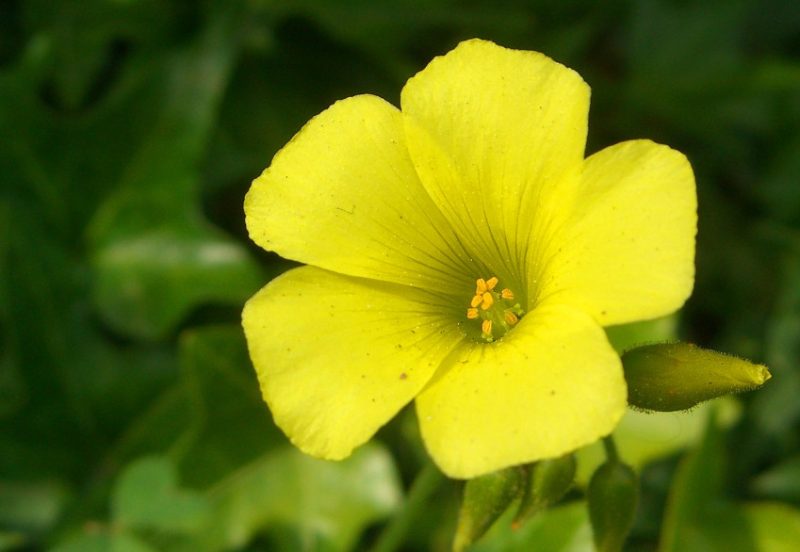
Originating in Africa, the Bermuda Buttercup (Oxalis pes-caprae) has spread to western North America. Its numerous yellow flowers are said to have led to its introduction outside of its natural area. But it has invasive tendencies, spreading quickly through bulbs and harming cattle with its toxic qualities.
Rubber Rabbitbrush
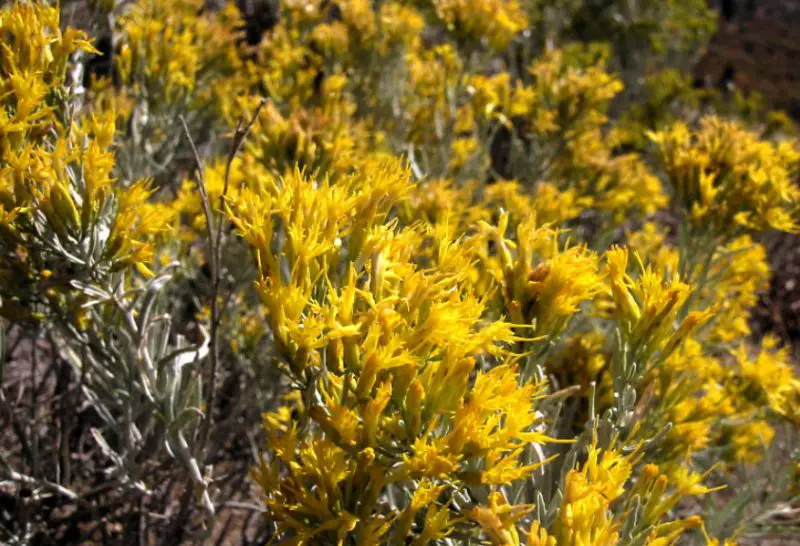
Native to the eastern United States and Canada, Rubber Rabbitbrush (Ericameria nauseosa) thrives in low-moisture settings throughout much of the eastern states and south to Texas. It grows in arid regions at high altitudes, producing clusters of little yellow flowers. It is inappropriate for damp garden settings, regardless of how plentiful or rare it is. Sometimes tea is made from its wildflowers.
Golden Ragwort
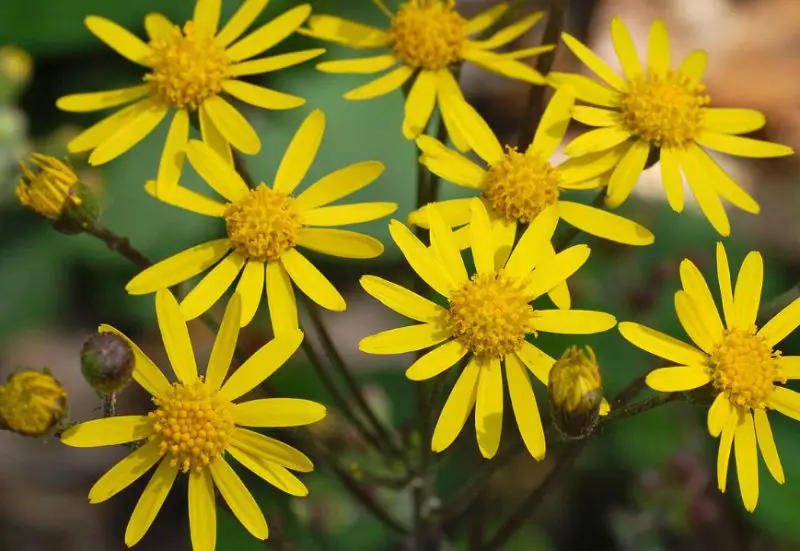
In the Eastern United States, golden ragwort (Packera aurea) grows in a manner similar to that of a weed and is frequently found among crops and by the sides of roadways. Known for its tiny yellow blooms that resemble sunflowers, it spreads quickly and is difficult to remove. Moths, for example, are natural biocontrol agents that are introduced to reduce its proliferation. Large, ground-level leaves that are preferred by moth caterpillars are seen in woodland areas.
Yellow Salsify
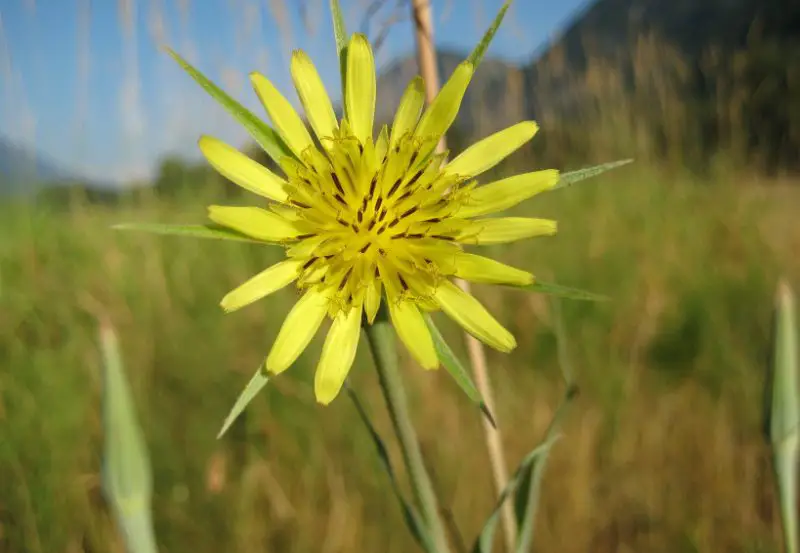
In western North America, yellow salsify (Tragopogon dubius) is widely distributed and dominates meadows with its abundance of yellow flowers from early spring to late summer. It can grow to a height of 20 to 30 inches, depending on the location. It is found in Canada, while the northern regions may have darker golden tones. Its leaves are fried, but its blooms are raw and edible all year round.
Yellow Sweetclover
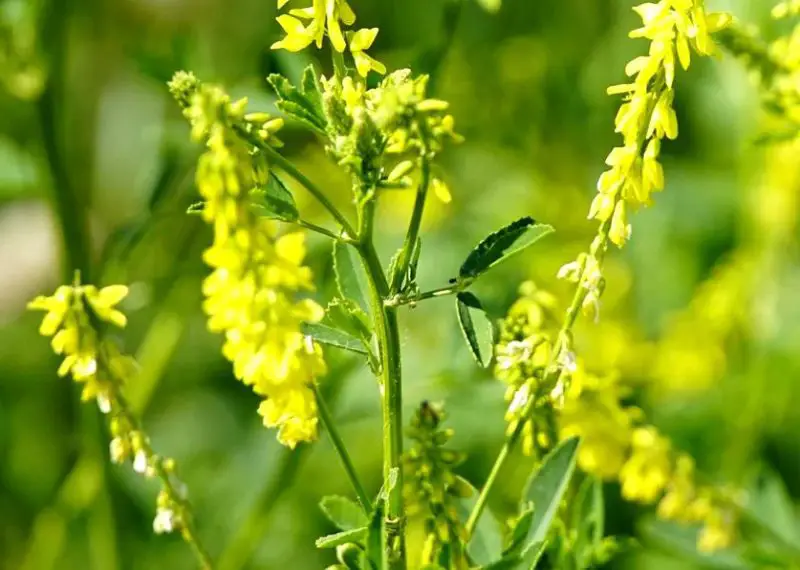
Moths, butterflies, and bees are drawn to the yellow sweetclover (Melilotus officinalis), which has tiny yellow blooms at the tops of its branches. But when mold grows, it’s extremely toxic and causes internal bleeding in cattle. Its thick roots make it difficult to eradicate as an invasive plant. In gardens, it’s frequently pulled out by hand or sprayed with weed killers to stop its towering growth, which can block sunlight and grow up to six feet tall.
Fennel
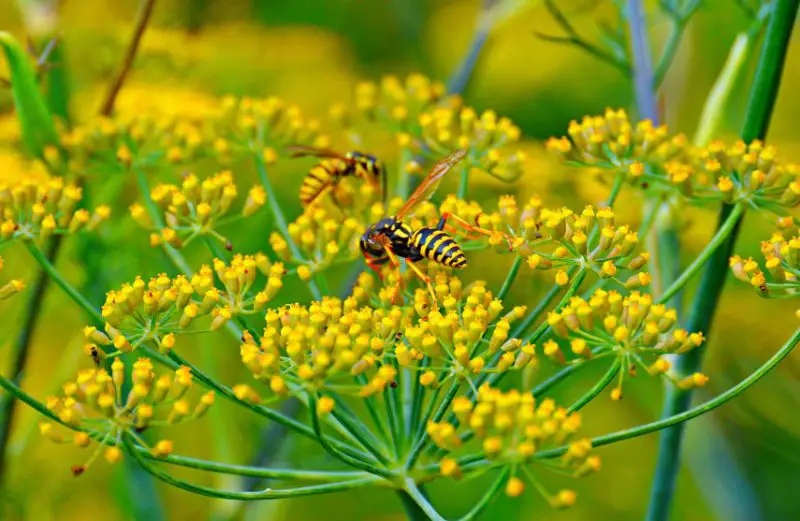
A versatile herb valued for its culinary and medicinal uses around the world is fennel (Foeniculum vulgare). Rich in history, this plant spans Europe and North America and features lovely yellow flowers and fluffy green foliage. Mosquito-repelling uses have been made of its scented seeds. Prized as an annual and biennial plant, fennel is highly grown for its unique aroma, which is evocative of star anise.
Seep Monkeyflower
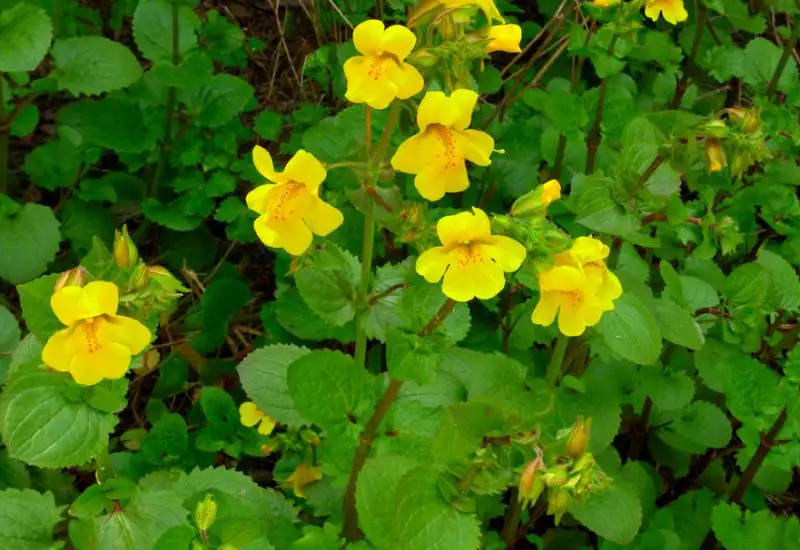
The little wildflower known as seep monkeyflower (Erythranthe guttata) is frequently seen along riverbanks in North America. It grows brilliant yellow blooms and unique golden-yellow foliage, and it prefers damp settings. Its leaves and blooms can be eaten fresh or cooked, and salads are a great way to enjoy them. This is a common culinary usage in areas with great availability, particularly the Pacific Coast.
Butterweed
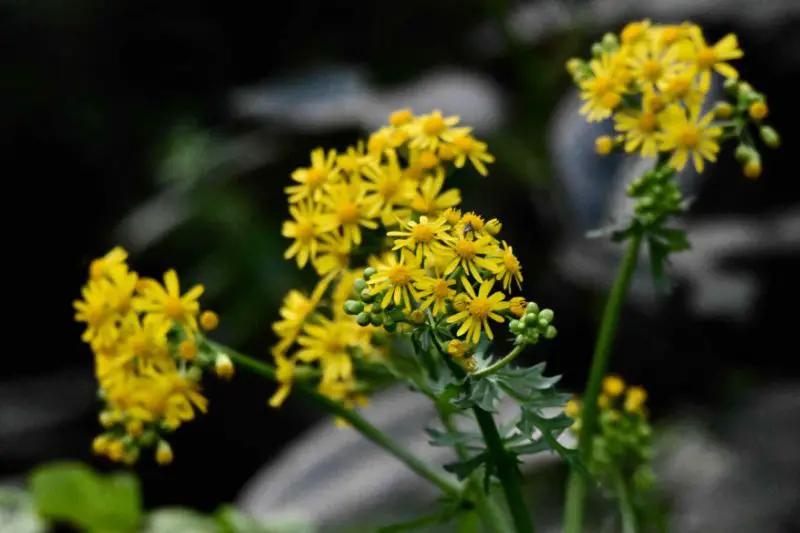
Native to North America, butterweed (Packera glabella) grows well in the central United States and produces little clusters of yellow blooms. Known for its extreme toxicity to people, it prefers damp environments such as marshes and clay soils. Even though it favors these conditions for quick growth, it can also be found at higher altitudes in prairies with moderate to high soil moisture content.
Slender Yellow Woodsorrel
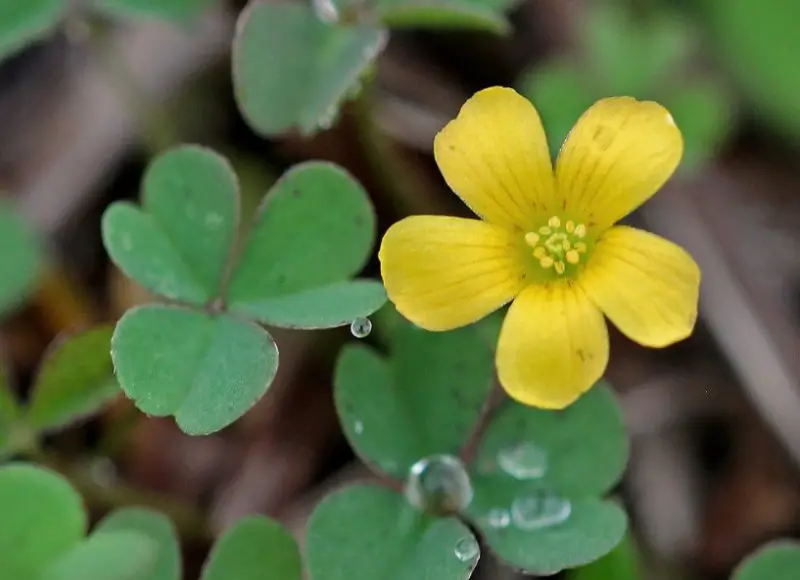
Slender Yellow Woodsorrel, or Oxalis dillenii, is unique in the woodsorrel family because of its upright growth habit and tiny golden or yellow-golden flowers. It grows to about 10 to 15 inches in height, with small blooms that can go as big as 0.8 inches in diameter. Commonly found near woodlands, it thrives in damp, well-drained soils.
California Brittlebush
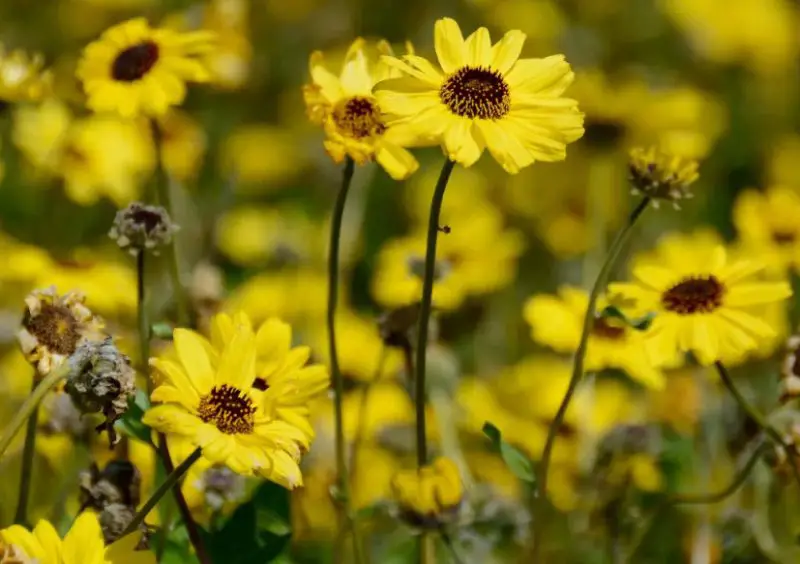
From Santa Maria to San Diego, the California West Coast is home to the California Brittlebush (Encelia californica). It has a maximum height of five feet and reaches heights and widths of many feet, like a bush. Richly adorned with a profusion of huge, fragrant yellow flowers, they draw a variety of species, especially the White-lined Sphinx and Fatal Metalmark, especially in the spring and summer.
Colt’s-Foot
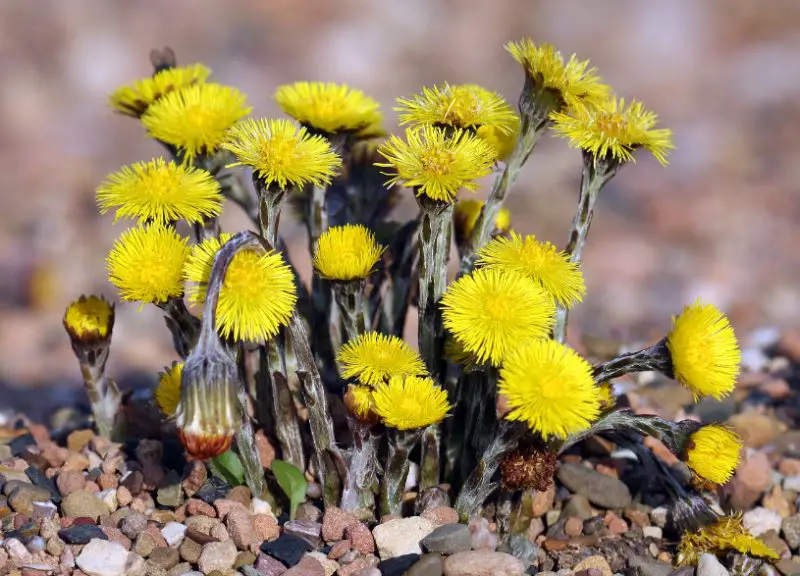
Colt’s Foot (Tussilago farfara) has huge, spherical, yellow flowers that resemble those of the common dandelions. Its tiny stature, ranging from 3 to 11 inches, fulfills multiple ecological and human functions, such as producing health-promoting herbal tea. Recent studies, however, point to possible toxicity, prompting national and international restrictions.
Cutleaf Coneflower
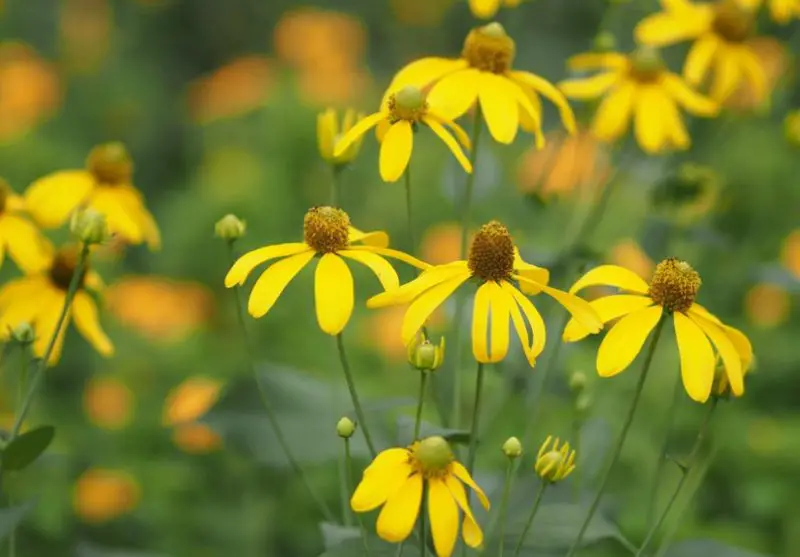
The vivid yellow blossoms of the Cutleaf Coneflower (Rudbeckia laciniata) have cores of orange and brown. It grows several feet tall, with some examples reaching up to 10 feet, and has an upright growth habit. Despite being widely cultivated, it is poisonous to animals, especially horses, pigs, and cattle. It is most frequently found in North America’s Great Plains region.
Golden Yarrow
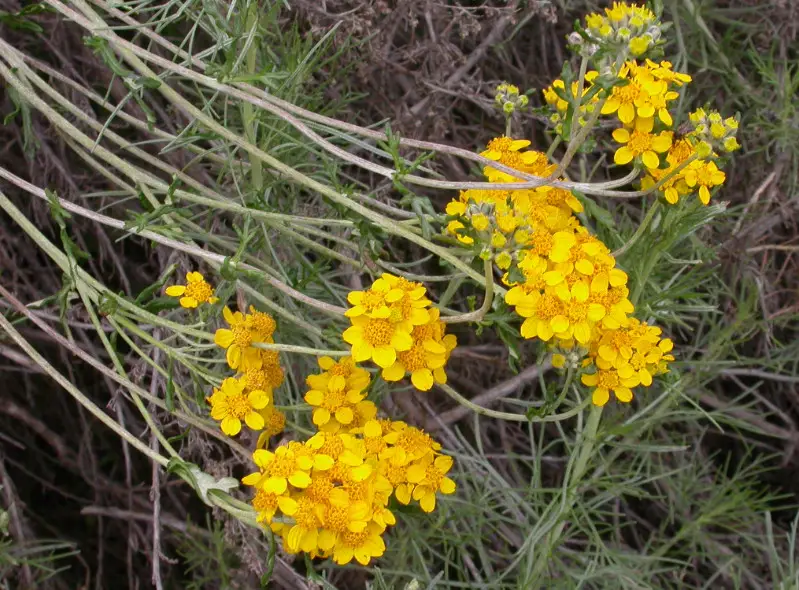
Eriophyllum confertiflorum, also known as golden yarrow, is a native plant of open spaces in North America. It grows best along the West Coast, where it produces dense clusters of tiny yellow flowers. It is found in at least three types throughout California; it grows to a maximum height of 20 inches in sunny settings. Baja California is home to it as well.
Marsh Marigold
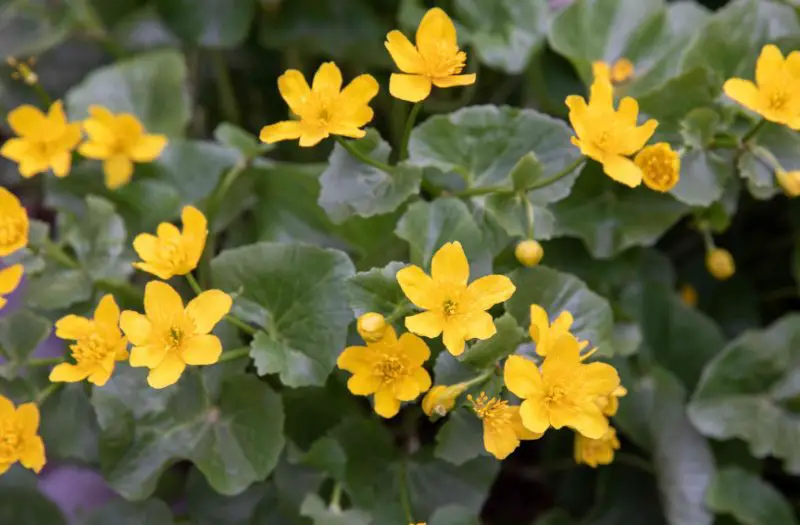
Although there are variations that are white or pink, the marsh marigold (Caltha palustris) has five big yellow petals surrounding a core yellow portion. It can grow invasive and outcompete local species, flourishing in wetlands. Although it is hazardous if consumed in large amounts, it is an essential food source for bees and provides copious pollen and nectar. It is poisonous to humans.
Downy Yellow Violet
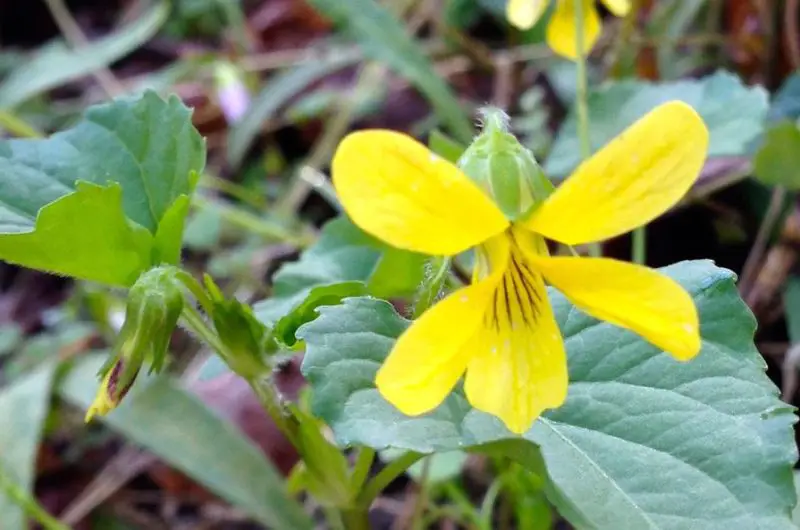
The Downy Yellow Violet, or Violeta pubescens, is found throughout North America in damp to dry forests. They spread quickly throughout the forest floor and are suited to dry woodland environments. They have little yellow flowers with four to five petals. The first series, which blooms twice in spring and summer and depends on pollination, but the later series self-pollinates and has continuous flowering all year round.
Greater Celandine
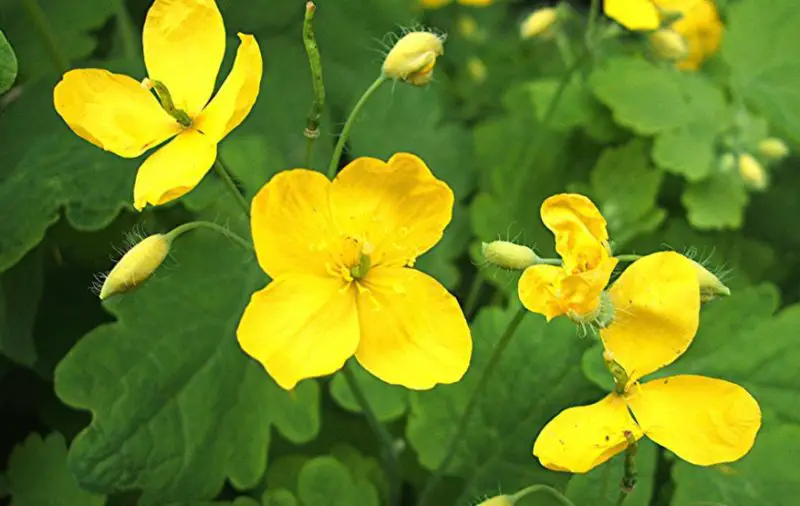
The invasive Greater Celandine (Chelidonium majus) plant is characterized by its little yellow flowers and quick growth. Even though it is poisonous, its extracts have therapeutic benefit and are used in antiviral medications. But because too much of it could be harmful to people, care should be taken. Its aggressive proliferation has led to its prohibition in several areas.
Western Wallflower
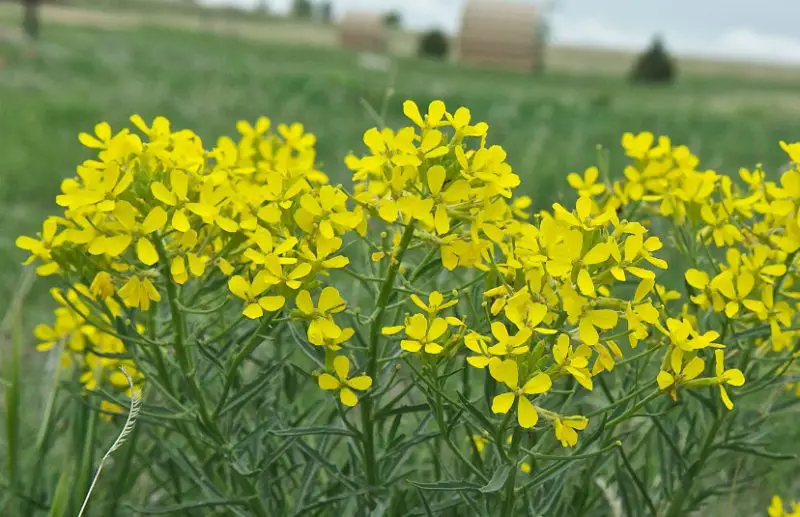
With its yellow or orange blossoms, the Western Wallflower (Erysimum capitatum) adorns forests, prairies, and coniferous environments in high elevations in Western North America. It draws pollinators such as ants, flies, and bees, making it an essential component of the ecosystem. Although it was previously widespread in California, it is now endangered throughout the state, though different subspecies are thriving in the Rocky Mountains.
Creeping Buttercup
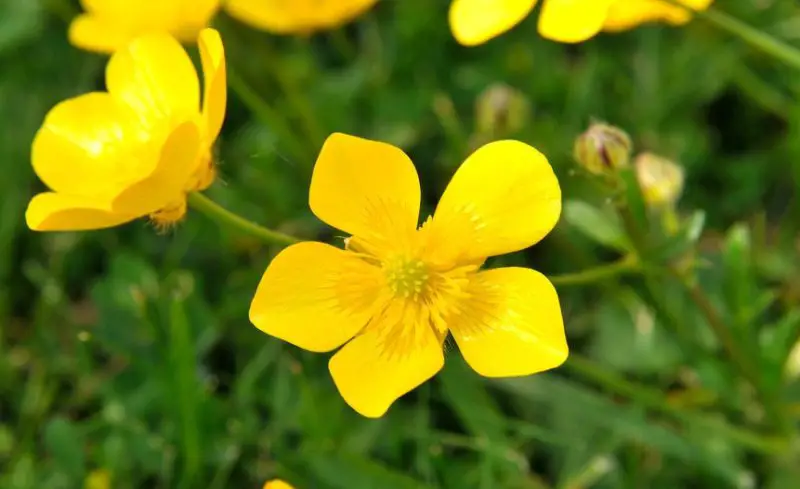
The vivid yellow flowers of the creeping buttercup (Ranunculus repens) have distinct core portions. It spreads quickly in disturbed regions, such as marshes, flooded zones, and irrigated fields, and is frequently invasive. Avoid it because of its bitter taste, as it is toxic to animals. Because of its deep roots, human removal is difficult; where possible, mechanical measures should be used instead.
Creeping Woodsorrel

Large yellow flowers with five petals, characteristic of the creeping woodsorrel (Oxalis corniculata), are what identify this plant on lawns across North America. Though invasive, it grows well in agricultural areas. It has nutritional value and is occasionally added to drinks, despite being intrusive. North America is home to a variety of creeping woodsorrel species.
Pale Jewelweed
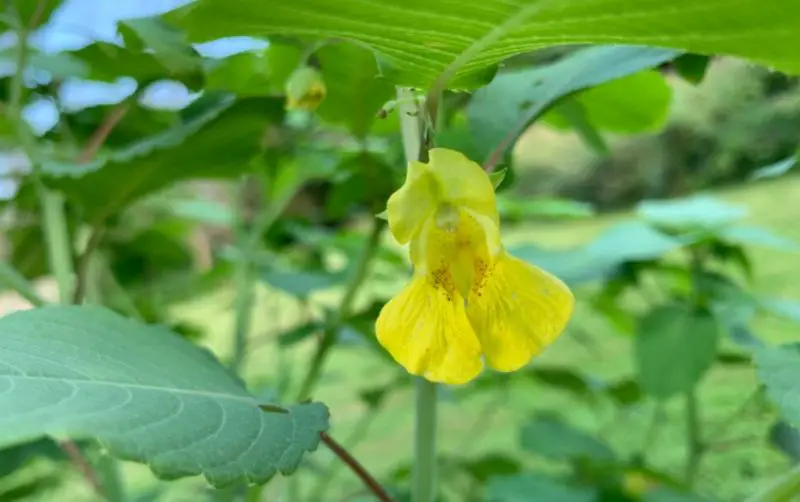
The towering, more than six-foot-tall pale jewelweed (Impatiens pallida) is covered in eye-catching yellow blossoms. Its copious amounts of nectar and pollen attract pollinators. It grows well in flooded areas and streams throughout the East Coast; its green parts are delicious and frequently used in drinks. It thrives in a variety of settings, from the Eastern United States to Canada.
Common Wrinkle-Leaved Goldenrod
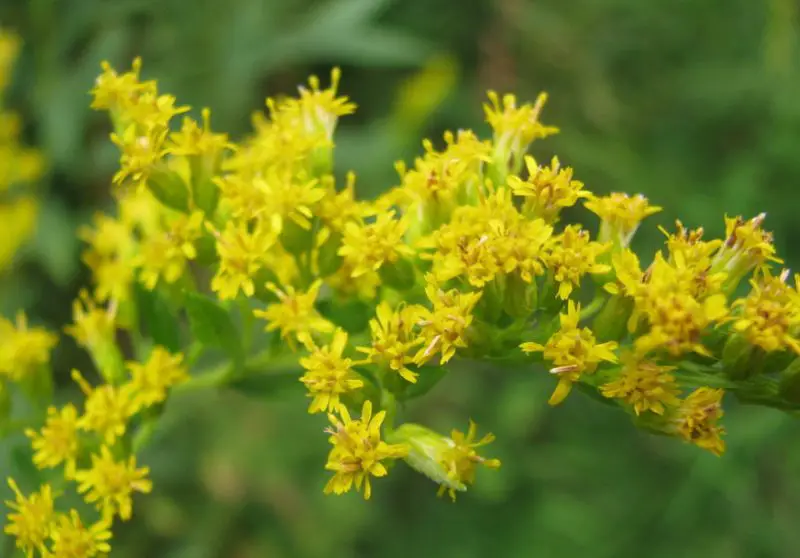
Common wrinkle-leaved perennials in the Eastern and Central United States, goldenrod (Solidago rugosa) bears several little yellow flowers on each plant. Growing in pastures, parks, and gardens, it has six types and one cultivar. Its decline in some US states is attributed to declining natural habitats.
Canada Goldenrod
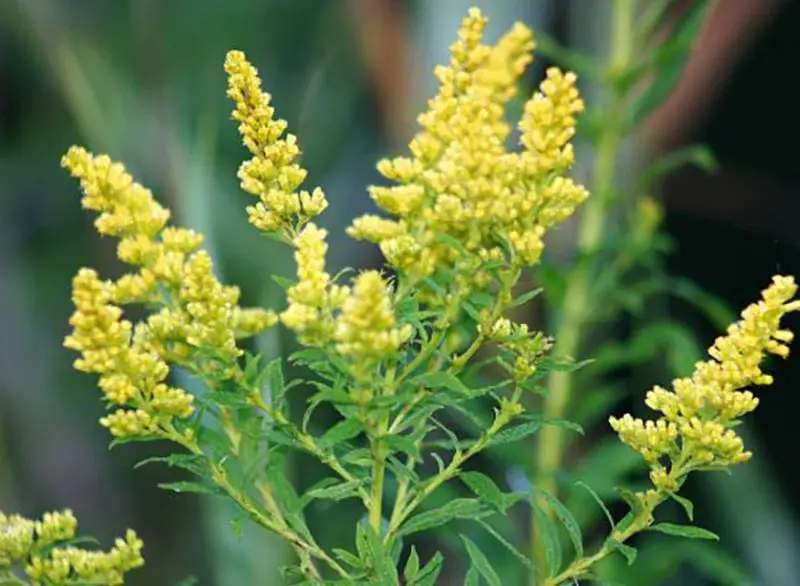
Canada Goldenrod (Solidago canadensis), a prominent yellow wildflower in North America, thrives in disturbed areas, often colonizing fire-affected dry land swiftly. It draws pollinators like flies and bees with its profusion of yellow flowers, which provide nectar and pollen. Even though it grows natively in North America, it has invaded other areas, most notably Asia, where it has displaced native flora.
False Sunflower
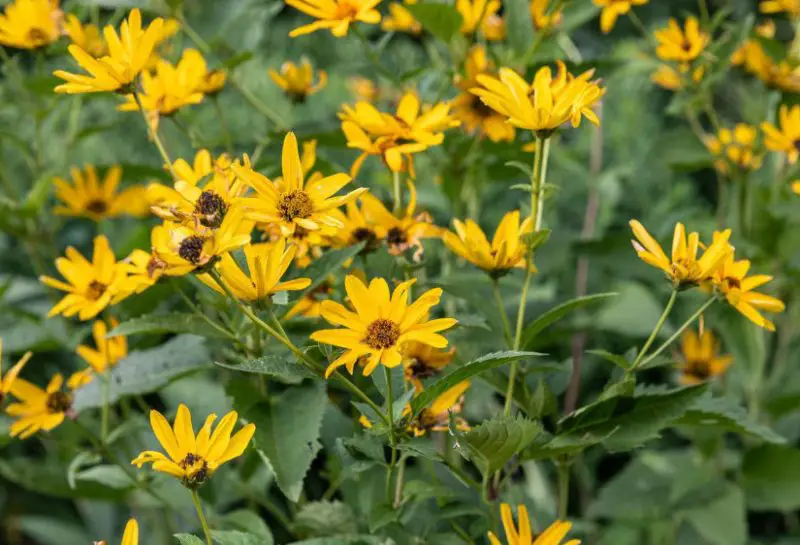
The False Sunflower (Heliopsis helianthoides), which has several varieties, grows well by roadsides and in gardens. It grows up to 50 inches tall and has beautiful, predominantly golden-yellow flowers that resemble common sunflowers. Although widely dispersed throughout North America, it is not found in the extreme North or West. It’s a member of the aster family and a favorite with wasps and bees.
Common Cat’s-Ear
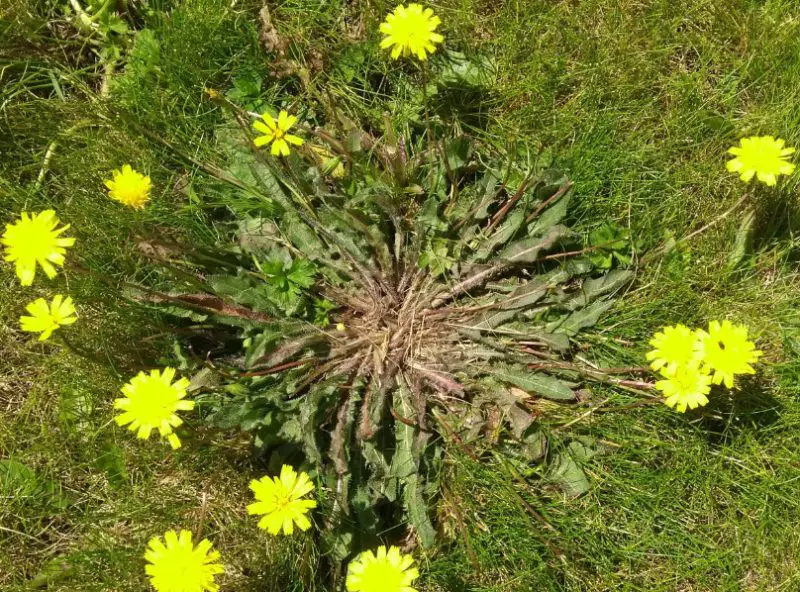
Common Cat’s-Ear wildflowers (Hypochaeris radicata) bear clusters of small yellow blooms, often becoming invasive in various habitats like gardens, lawns, and farms. One plant can produce up to 5,000 seeds; thus, even with physical removal efforts, their tenacity comes from seed distribution. Often, herbicides are needed to control them, particularly in agricultural environments with high soil moisture content.
Shortpod Mustard
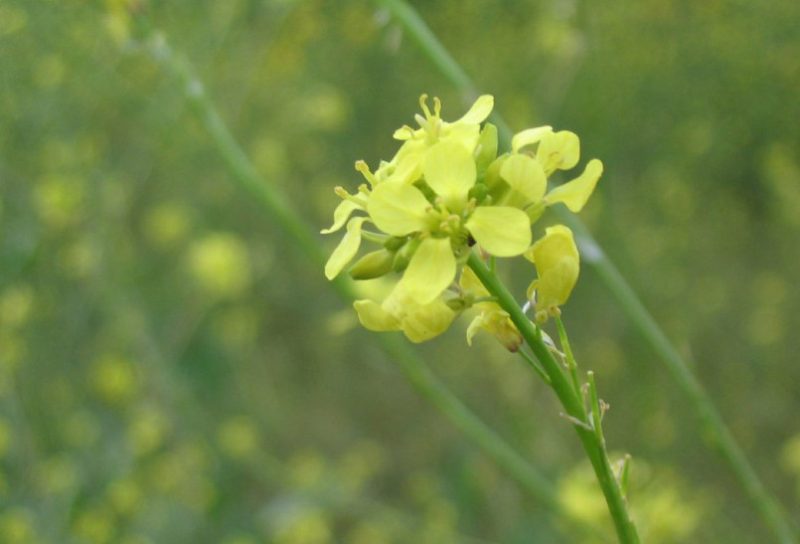
With many small yellow blossoms, Shortpod Mustard (Hirschfeldia incana) is a widespread wildflower in North America and Europe. Originating in Southern Europe, it is smaller than other wild mustards and thrives in high-elevation environments such as plains. Its quick expansion over the highlands of North America frequently results in invasive growth, displacing native flora in prairies and deserted places.
Bluestem Goldenrod
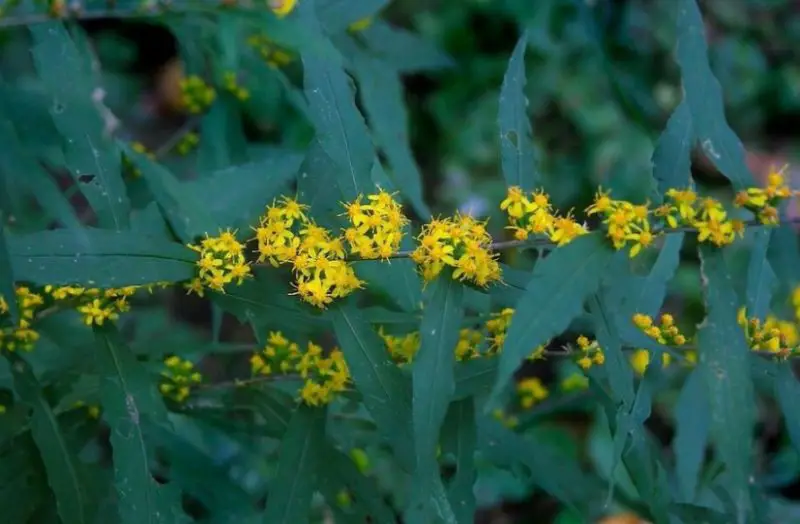
The common species Solidago caesia, or bluestem goldenrod, is over one foot tall and can be found in gardens and a variety of environments across North America. It grows to a maximum height of three feet and is a prolific bloomer of tiny yellow flowers. It does well in garden beds and containers with damp soil. Its flowers, which are not fragrant, beautify modest spaces all summer long, and the plant remains green until late autumn.
Common Fiddleneck
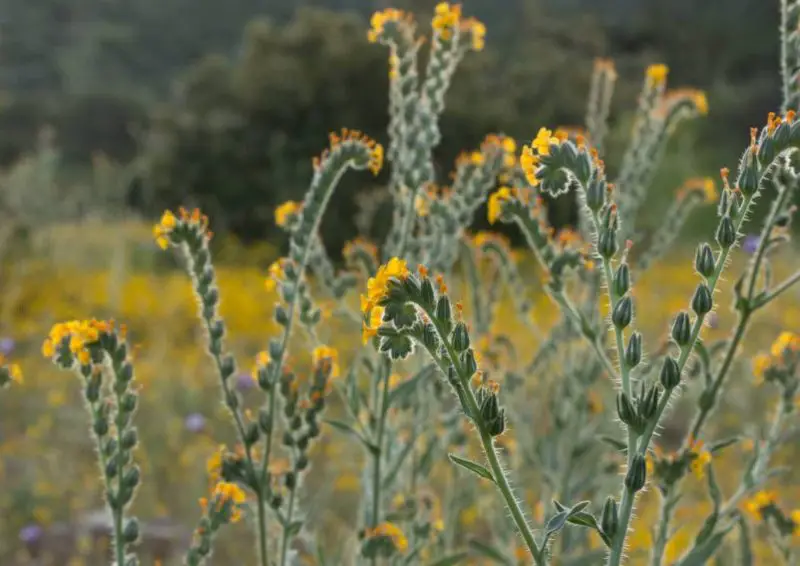
The flowers of the Common Fiddleneck (Amsinckia menziesii) are dark yellow in color, with occasional orange hues. It is native to Oceania, which includes Australia and New Zealand. It can also be found in North America west of the Rocky Mountains, where it grows well in a variety of temperatures as far north as Alaska. It is suited to warmer climates, such as those in Western Mexico, because of its hairy stems and leaves. These kinds are widely available in Western North America.
Tansy
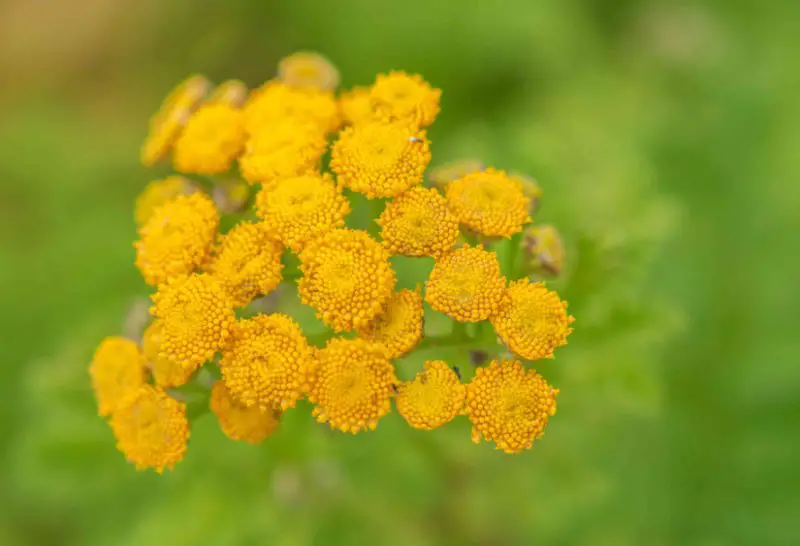
Known for its button-shaped blooms on tall stalks, the tansy (Tanacetum vulgare) is a popular yellow wildflower in Europe, Asia, and North America. It grows to be more over fifty inches tall and thrives in direct sunlight. It is utilized in traditional drinks and cuisines and, although it can be harmful if drunk in excess, it retains its fragrance even when dried. Only Tansy will satisfy the metallic green and yellow colors of the Tansy Beetle.
Bitterweed
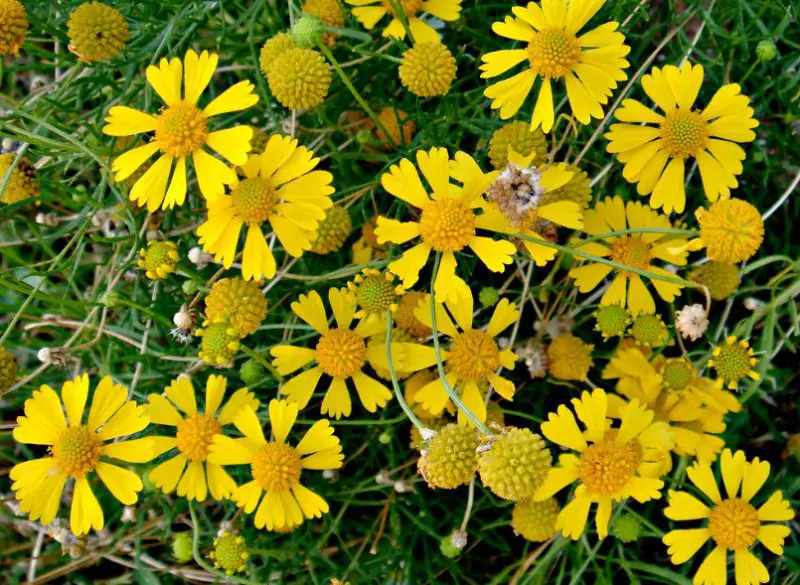
Helenium amarum, or bitterweed, is an extremely toxic plant that grows well in southern and southeast areas like Louisiana. It has tiny yellow blooms. It is frequently found in grasslands, close to water sources, and by the sides of roads. The reason for its rapid development along these areas is the dispersal of seeds during mowing. It can grow up to two feet tall, but is usually kept shorter on well-kept roadsides. Because it tastes bad to wildlife, it can spread unchecked in unmowed meadows.
Yellow Iris
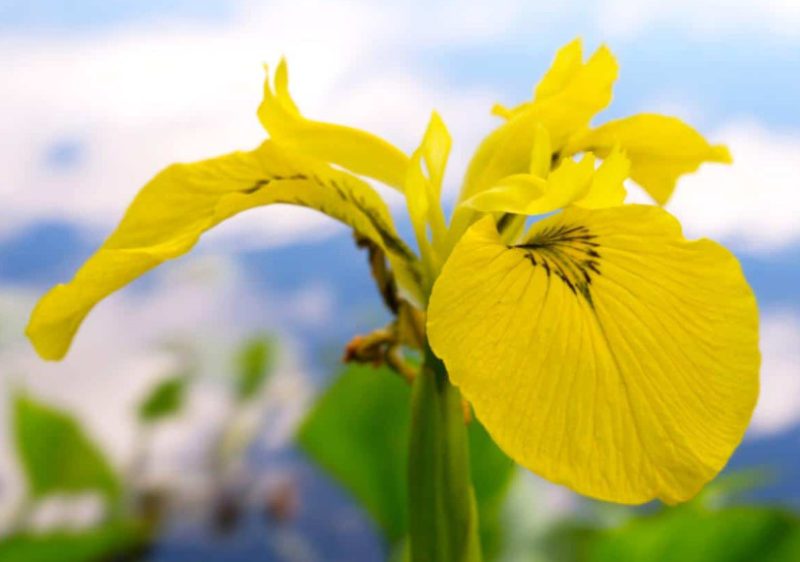
The Yellow Iris (Iris pseudacorus) has some of the largest yellow flowers in North America, with a diameter of almost 4 inches, and grows up to 40 inches on tall stems. It grows best in temperate climates with plenty of soil moisture and is an essential nectar source for bees and other insects. It is invasive in aquatic habitats and has been shown to surpass native plants in many US states, including Washington.
Camphorweed
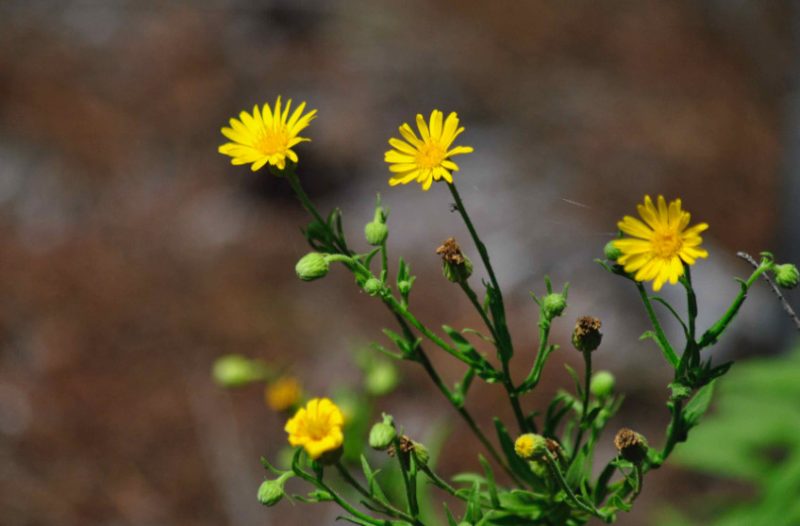
From spring through summer, camphorweed (Heterotheca subaxillaris), a prevalent weed in the Southeastern United States, especially in Florida, displays its yellow blossoms. It might possibly bloom all year round in the southern parts of Florida. Usually small, some examples grow up to three feet in height. It grows well in full sun and is found all around the state on beaches, dunes, and dry soils.
Oriental False Hawksbeard
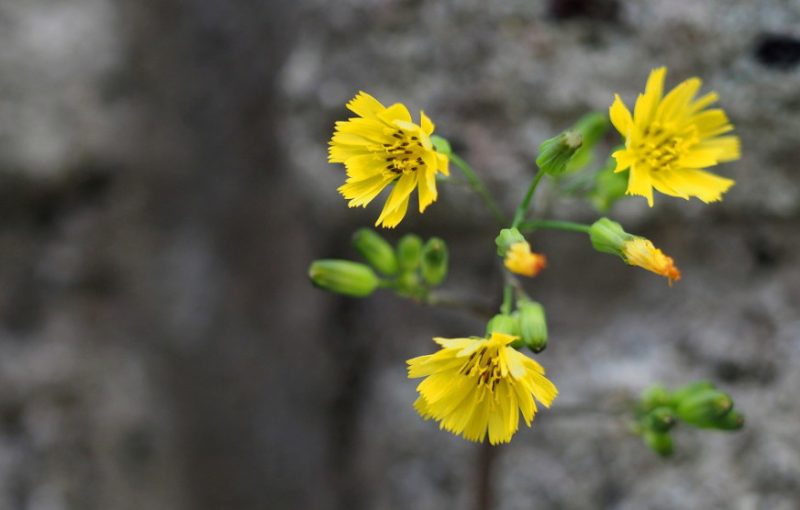
The Oriental False Hawksbeard, or Youngia japonica, is an invasive yellow wildflower that is a member of the aster family. It grows all year round in many places with tiny blooms that are less than 0.5 inches in diameter. Herbicides are used in overgrown regions and flowers should be clipped before they dry, as seeds can quickly spread. It quickly spreads outside of controlled areas in woodlands.
Lance-Leaved Coreopsis
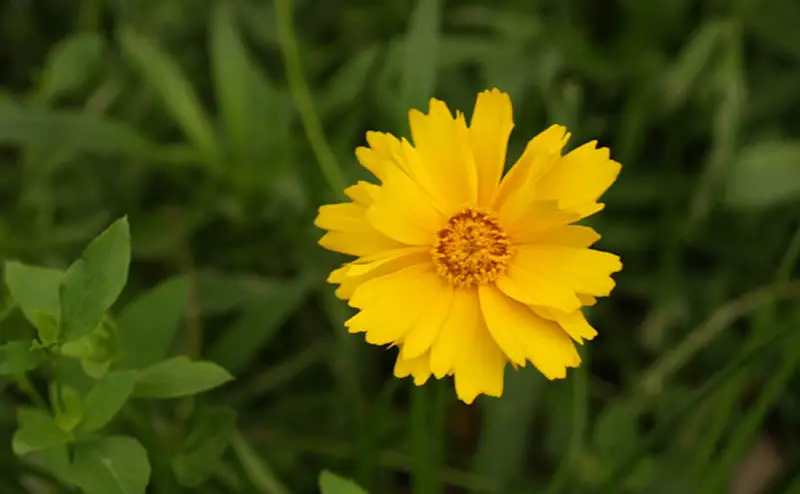
Lance-leaved Coreopsis (Coreopsis lanceolata) is a perennial with vibrant all-yellow flowers up to 2 inches in diameter. Its lance-shaped leaves, which are primarily grouped toward the base, grow to a height of two feet. These deeply cut, up to 3-inch-long leaves hardly ever get in the way of the flowers, which are positioned in opposition to one another along the stems.
Upright Yellow Woodsorrel
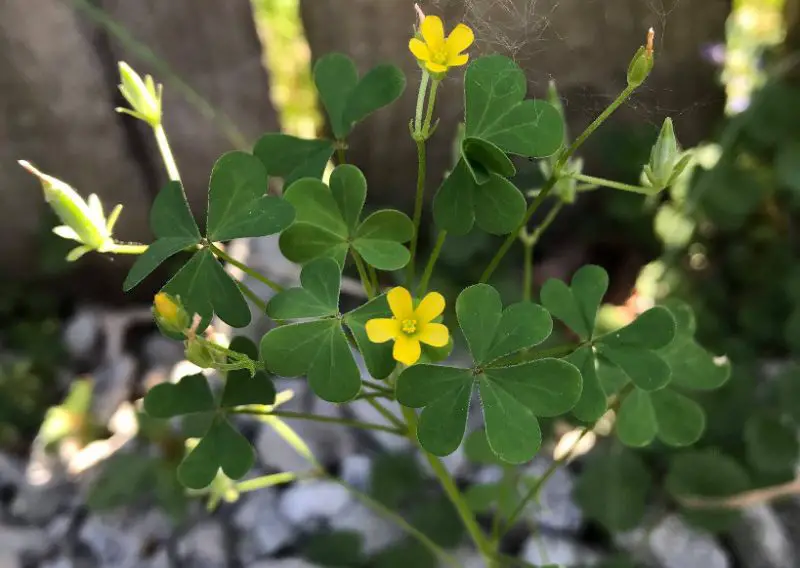
Known by several names, including Sheep Weed, Oxalis stricta, the upright yellow woodsorrel, is a native of North America. It has little yellow flowers with five petals surrounding a green core, which are frequently encountered as a nuisance in gardens. Blooming from summer to fall, it spreads quickly and thrives in damp garden soils. Remarkably, it can also be utilized to create a cool summertime drink.
Common Cinquefoil
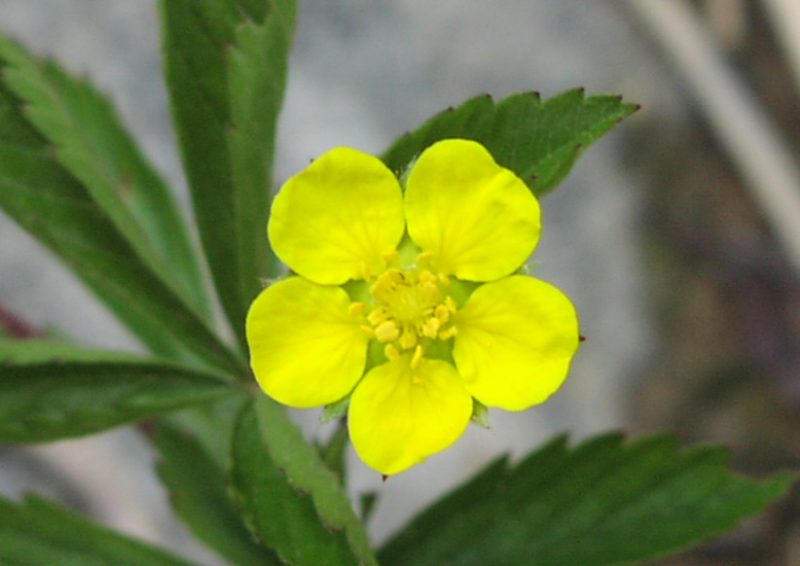
From Canada to the southern United States, a wide swath of North America supports the Common Cinquefoil (Potentilla simplex). Its distinctive little yellow flowers, which have five petals and a central yellow portion, are found in wooded environments. Its edible stems and blooms, which bloom profusely from April through June, are highly valued complements to a variety of meals. Its blossoms, which are abundant in pollen, draw a variety of animals, such as carpenter bees and other bee species.
Grey-Headed Coneflower
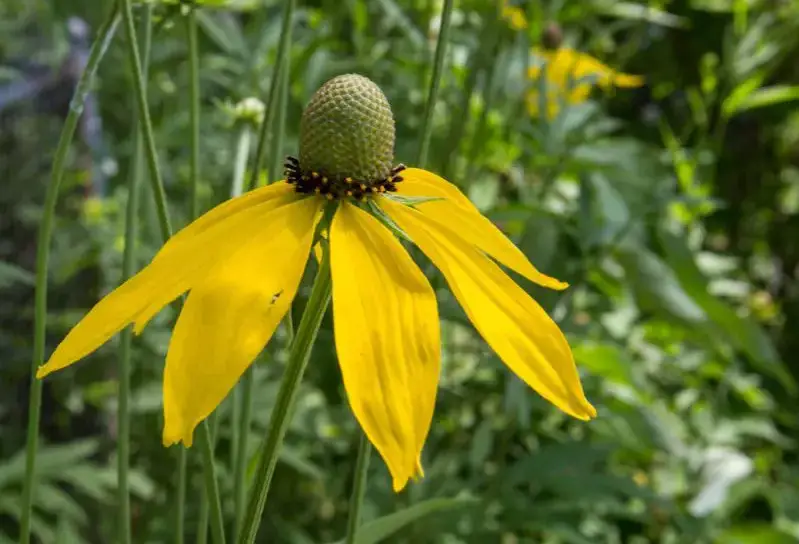
Native to North America, the Grey-headed Coneflower (Ratibida pinnata) is distinguished by its bright yellow petals and gray central disk. Rising to a height of 5 feet, never falling below 3 feet, it towers over perennials. Blooming in full light, it grows in a variety of environments, especially plains, where its thick growth changes the scenery with its elegantly falling petals.
Engelmann Daisy
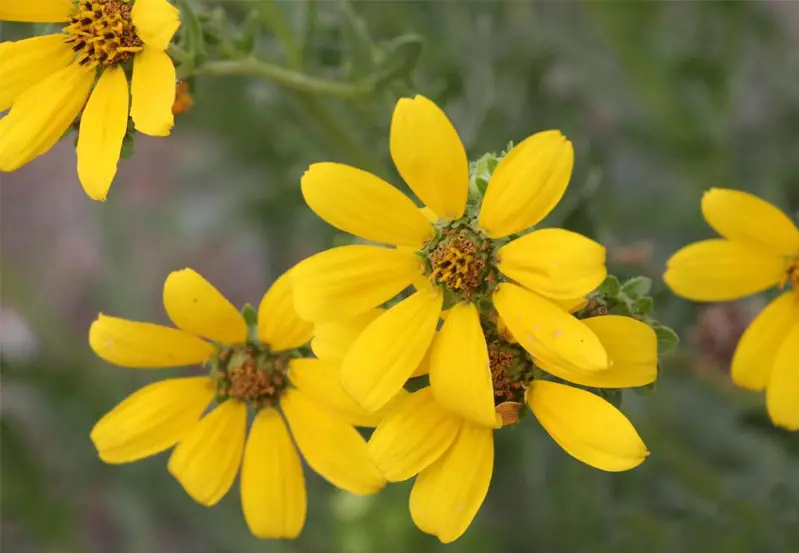
Growing in rosette-like formations, Engelmann Daisies (Engelmannia peristenia) have vivid yellow petals. They are native to high altitudes and grasslands, and they are frequently grown as border plants in gardens. They often grow to a height of 12 inches, and they do well on even the worst soils. They are an important source of food for wildlife and are mostly propagated by seeds in the fall, but in some grassland and meadow habitats, they may be threatened due to their susceptibility to habitat degradation.
Cup Plant

The enormous golden flowers of Cup Plants (Silphium perfoliatum) can have up to thirty rays. They exist in two types and are found in temperate regions of the world, including North America. Their large roots can make them invasive outside of their natural region. They have industrial potential, are raised without the use of pesticides, and can be used as animal feed and soil stabilizers since they don’t face a lot of pest pressure.
Telegraphweed
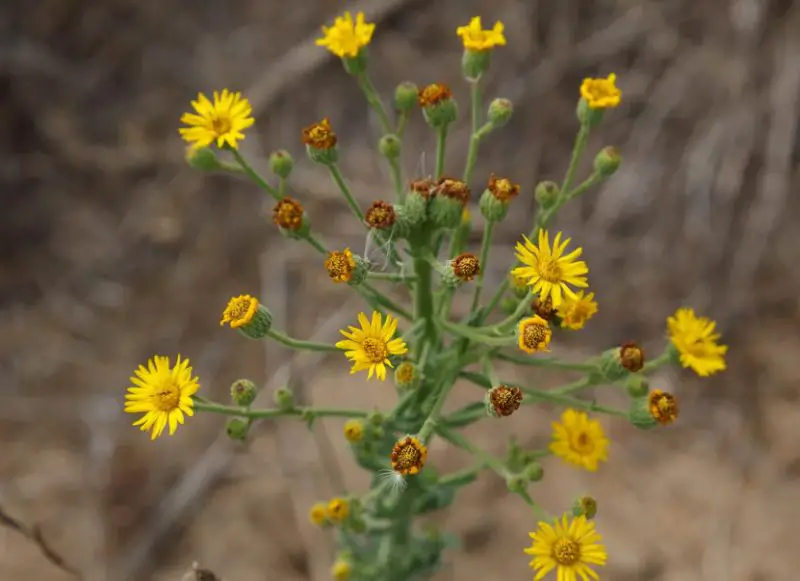
In California, telegraphweed, or Heterotheca grandiflora, is a common sight with its yellow flowers that resemble those of common sunflowers. Both the inner and exterior seeds—especially the ones on the outer blooms—help it spread quickly. It welcomes pollinators and a variety of caterpillars with its year-round blossoms that stretch from Mexico to San Diego and even further to Sacramento. Reaching normally 2 to 3 feet in height, it grows erect.
Largeflower Bellwort
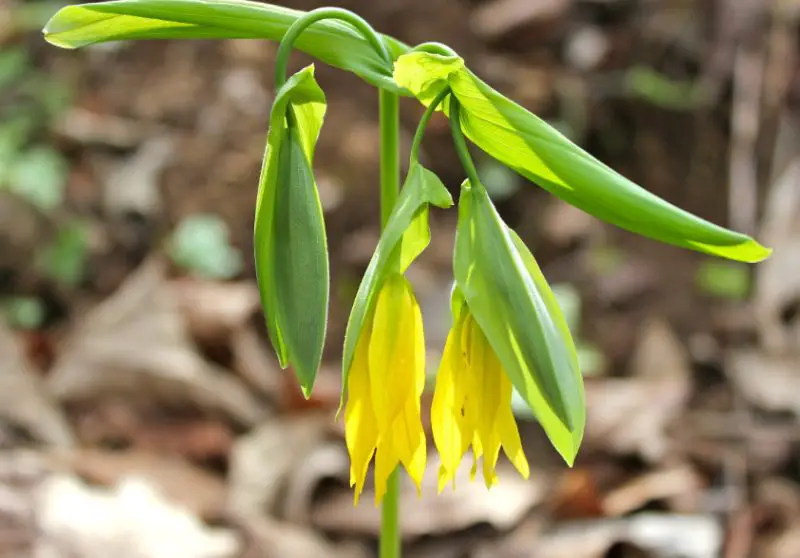
The large flowers of the Largeflower Bellwort (Uvularia grandiflora) give rise to the name. After flowering, its long, outward-pointing petals gracefully fall off. Climbing to a height of 30-35 inches, it has yellow blooms in the shape of bells. While bumblebees and other bees visit its blossoms, ants help spread seeds. Its preferred habitats include marshes, forests, and moist soils.
Northern Seaside Goldenrod
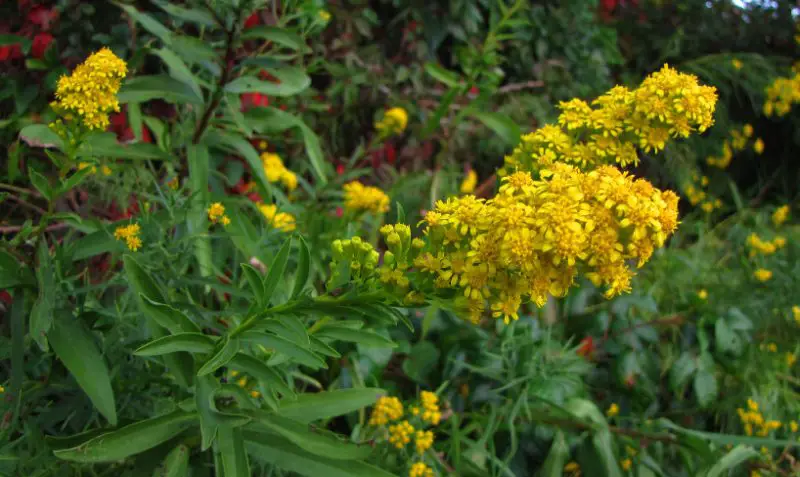
The tall flowerheads of Solidago sempervirens, often known as the Northern Seaside Goldenrod, make it stand out. It is one of the tallest yellow wildflowers in North America, growing up to six feet tall. It draws a wide diversity of butterflies and thrives in salt marshes. It is specific to the north and sets itself apart by spreading and blending in with other species of goldenrod.
Shrubby Cinquefoil
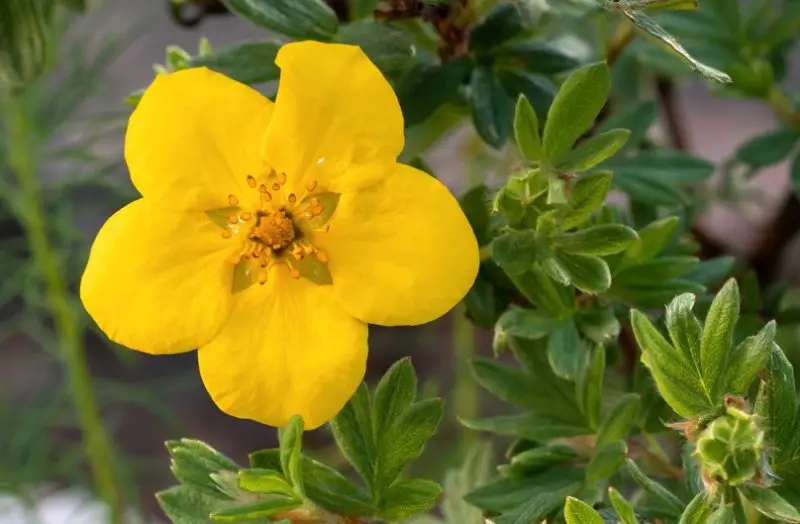
Shrubby Cinquefoil (Dasiphora fruticosa) grows like a shrub and has a profusion of yellow blossoms. This garden-friendly wildflower may grow up to 6 feet tall and thrives in both full sun and partial shade. Its little green leaves contribute to its unique appearance, and gardeners like it because of its resistance to pests.
Velvetleaf
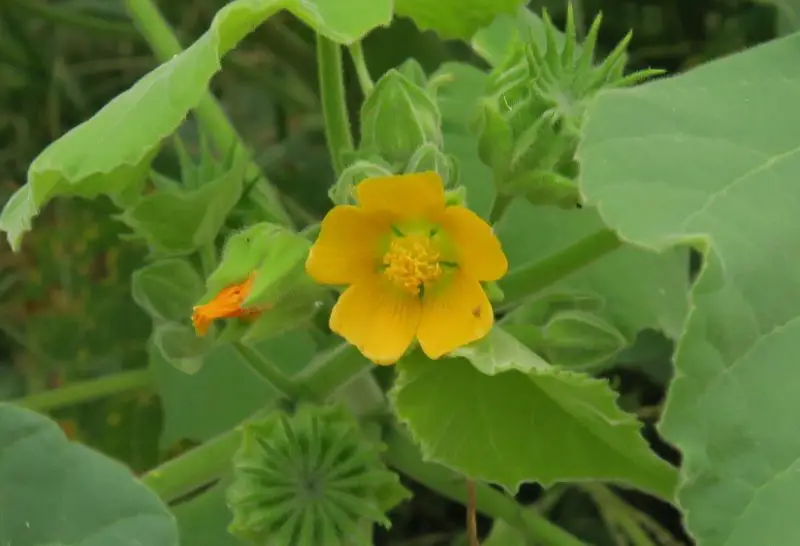
The 8-foot-tall velvetleaf (Abutilon theophrasti) is a sight to behold, crowned with tiny, one-inch golden blossoms. Known to be among the tallest invasive plants in North America, it is dangerous for crops such as soy. Surprisingly, it is grown for its delicious leaves in several parts of Asia, demonstrating a distinct dynamic from its invasive tendencies.
California Buttercup
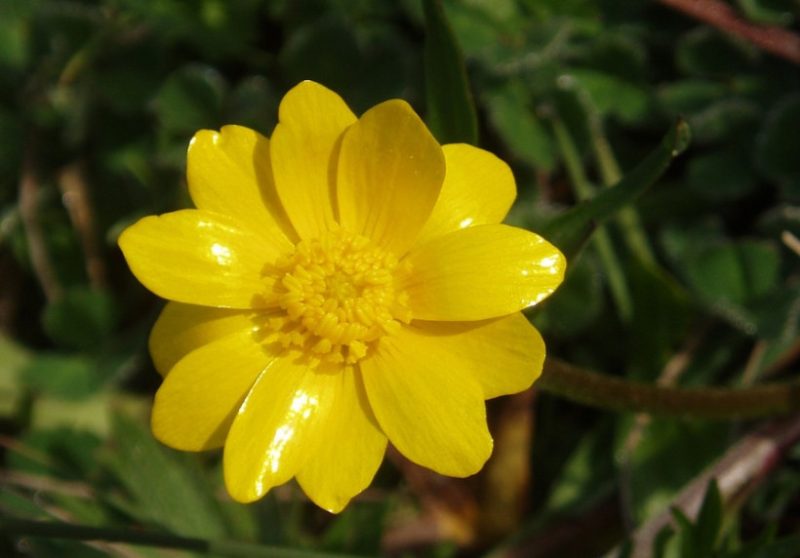
The California Buttercup (Ranunculus californicus), with its all-yellow flowers with overlapping petals, is a flourishing plant in the chaparral of the state. It can grow up to two feet tall and produces tiny flowers that are one inch across. It’s a welcome addition to gardens and is regarded as an ornamental plant with little chance of aggressive spreading.
Fringed Loosestrife
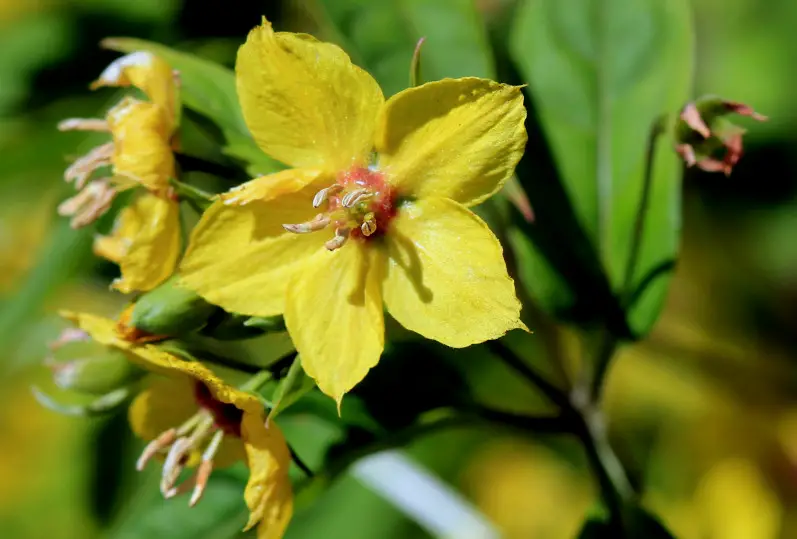
Native to Northern North America, Fringed Loosestrife (Lysimachia ciliata) boasts enormous yellow flowers with five petals. Apart from nectar, it provides nourishing plant oil, drawing in bees such as the oil-dependent, ground-nesting Macropis nuda. The fact that Fringed Loosestrife is the only food source for these particular bees emphasizes how important it is to their existence.
Common Dandelion
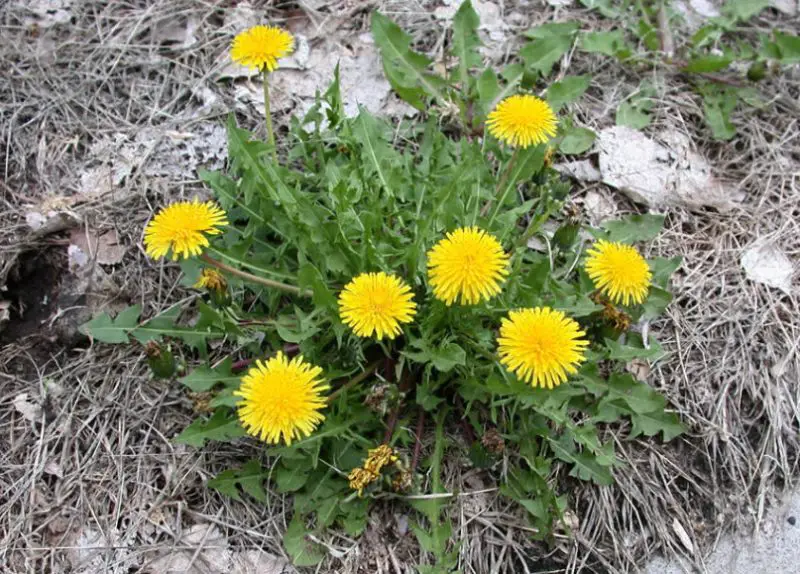
The common dandelion, or Taraxacum officinale, is well-known for its vivid yellow blossoms and general ubiquity. Its spherical bloom heads, which beautify fields all summer long, are a common sight in North America and Europe. With over 100 seeds produced from a single flower head, this prolific plant’s amazing seed production is responsible for its wide dispersion.
Great Mullein
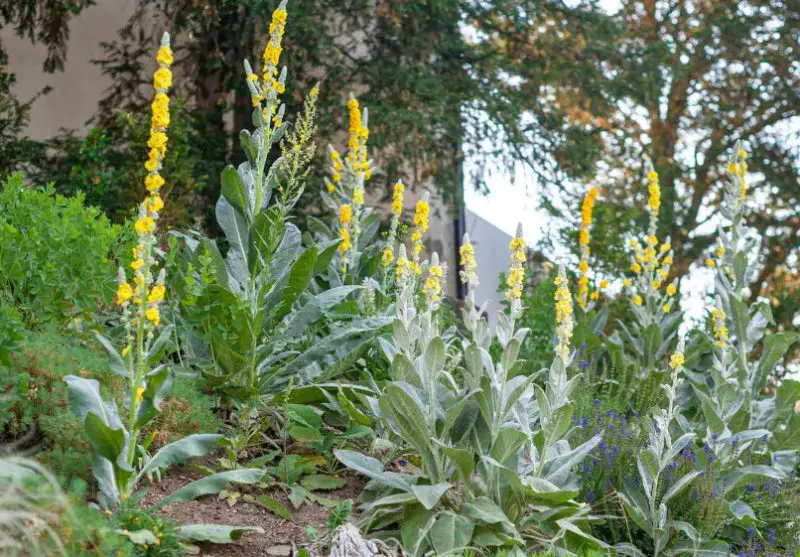
The Great Mullein, or Verbascum thapsus, is a well-known invasive species that thrives best in disturbed environments. It is distinguished by clusters of tiny yellow blooms. It is a fierce space competitor that frequently takes over fields and croplands. Its dense growth inhibits other plant species, making it obvious that it is an invasive species. Because Great Mullein flower capsules can yield up to 700 seeds apiece, they multiply quickly, which adds to the plant’s invasive status.
California Poppy
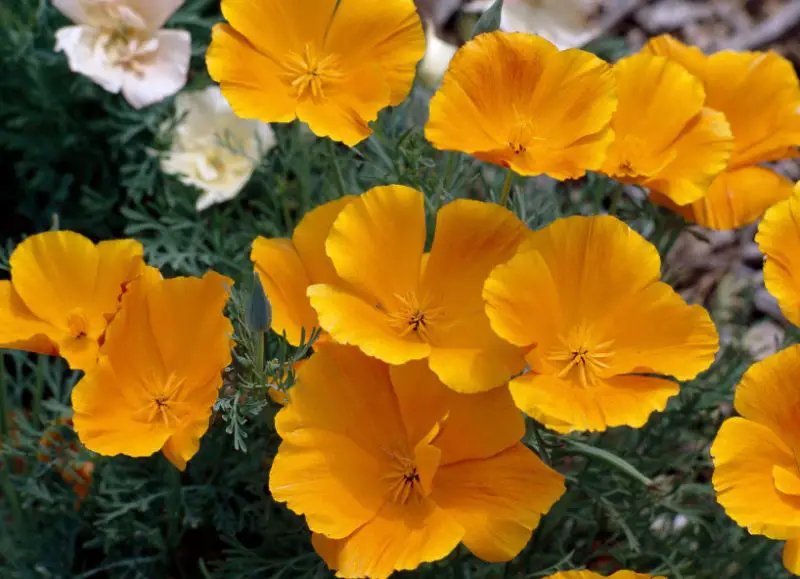
Eschscholzia californica, sometimes known as the California poppy, is easily identified by its vivid yellow, orange, or red flowers. It flourishes as a perennial in California and Mexico, blooming from spring to summer. It is deemed invasive when found outside of its natural range. One of its subspecies, the Mexican Gold Poppy, is found throughout the Sonoran Desert and has eye-catching yellow colors.
Black-Eyed Susan
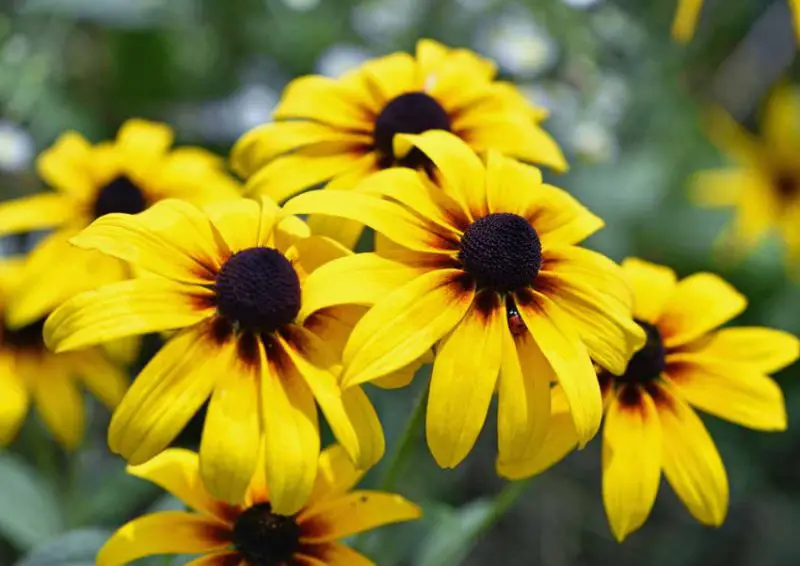
Rudbeckia hirta, also known as the Black-eyed Susan, is identified by its remarkably enormous yellow blooms with brown centers. It comes in four types, and is most popular in Mississippi and Maryland. With a lengthy history, Native Americans treasured this 18-inch-tall North American plant. Even though it is poisonous to tiny animals, it is still a widely grown species.
Lesser Celandine
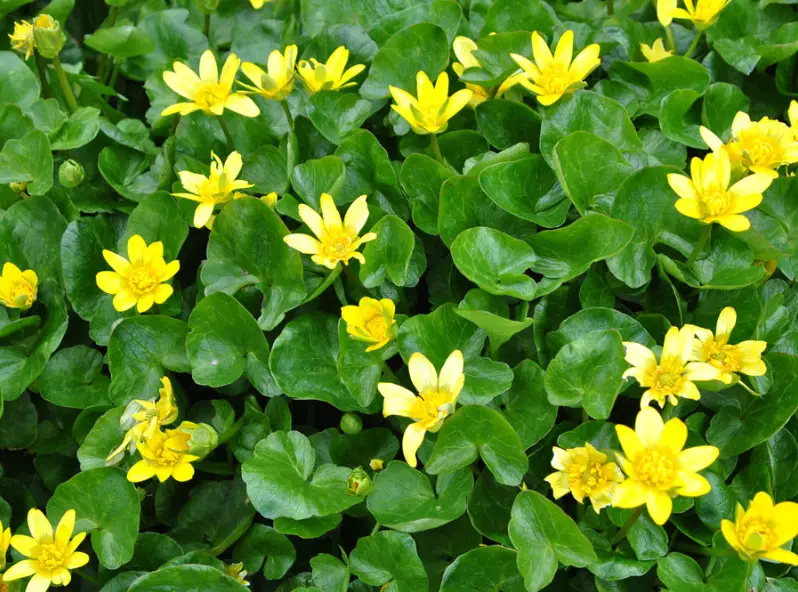
The Lesser Celandine (Ficaria verna) is a springtime bloom that lasts throughout summer. It has unique yellow petals that surround a core yellow portion. It was brought to North America and shows signs of invasion. Even though it’s beautiful, it’s dangerous since it poisons horses and cattle, which is why it’s classified as a noxious weed in several US states.
Yellow Trout Lily
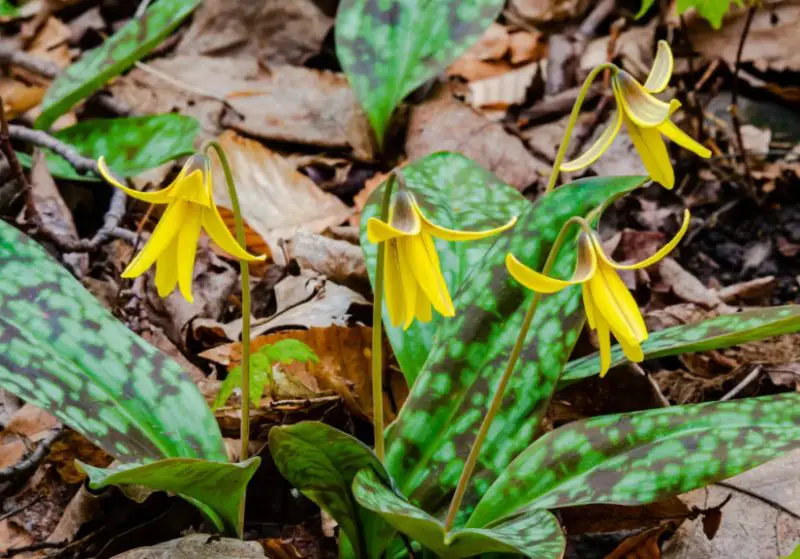
The Yellow Trout Lily (Erythronium americanum) has six enormous petals that are completely yellow and often measure between 20 and 30 mm in diameter. The two subspecies in North America differ somewhat, although both have yellow blooms. These wildflowers, which can last for millennia, are found in colonies from Georgia to the northern parts of Canada.
Bird’s-Foot Trefoil
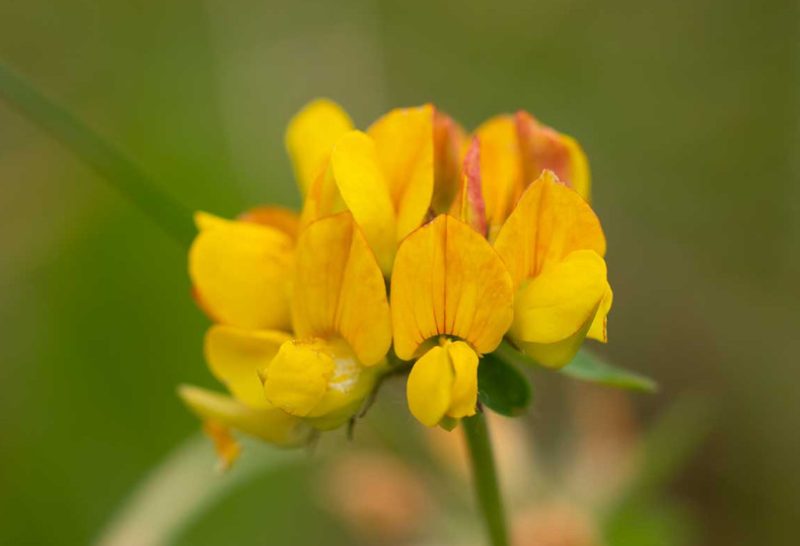
The Bird’s-foot Trefoil (Lotus corniculatus) usually has yellow flowers, but sometimes they have orange tones. This wildflower was brought to North America and, despite its beauty, has spread like wildfire. It was once planted to reduce soil erosion along highways, but it spreads quickly and forms large colonies that outcompete the natural vegetation, especially near the roads.
Partridge Pea
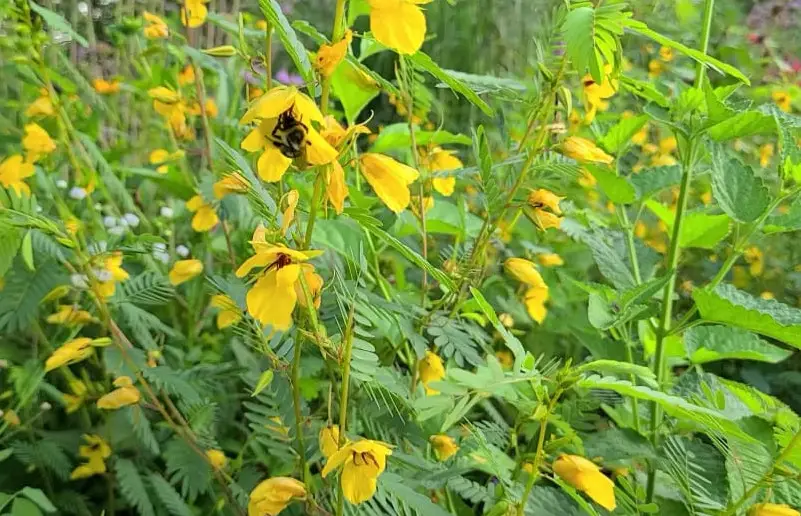
The vivid yellow colors of the partridge pea (Chamaecrista fasciculata) make it stand out. Known as the “Sensitive Pea” because of its reaction to contact that causes it to drop its leaves, it is an essential food source for bees, deer, and caterpillars on butterflies. Caterpillars from North America like this plant as a host because of its clusters of tiny yellow blooms.
Common Sunflower
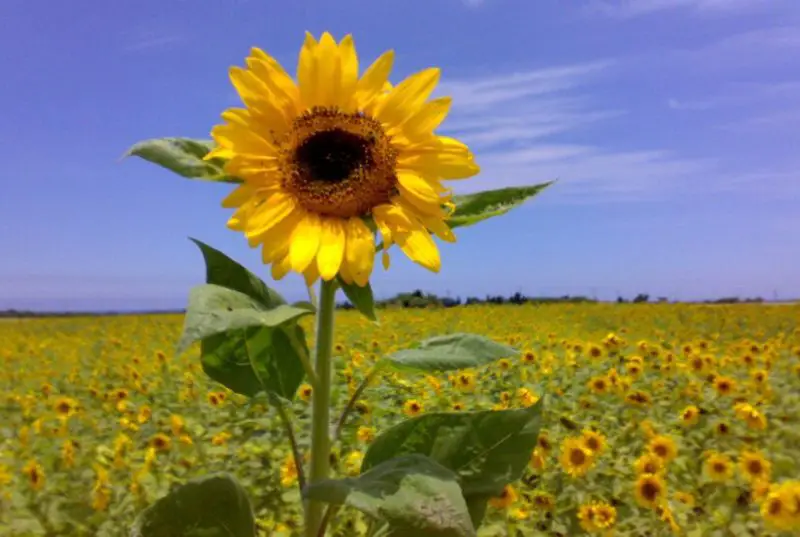
Common sunflowers, or Heliocentrus annuus, are some of the biggest yellow wildflowers in the world. Each plant can grow up to 10 feet tall and produce a single flower. They were brought to North America and are happy in fields of crops. Their seeds are multipurpose; they can be pressed into oil, cooked, or eaten. There are known instances that are exceptionally tall.
Prickly Sowthistle
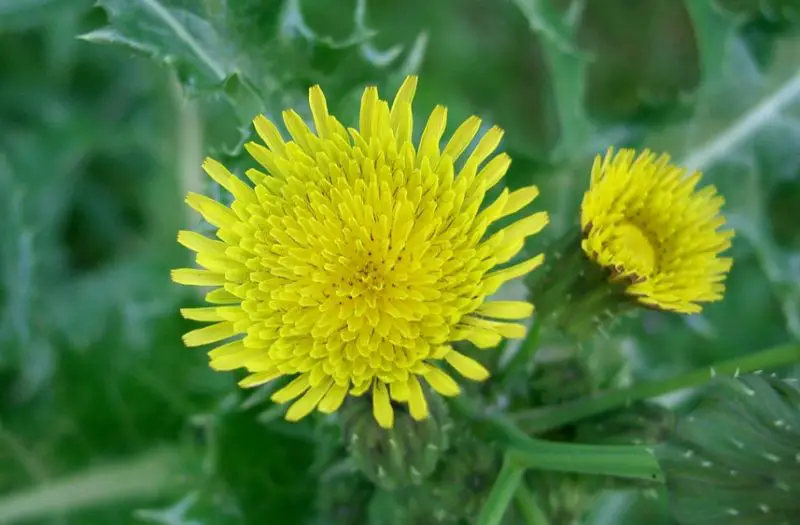
Prickly Sowthistle (Sonchus asper), a member of the asters family, has yellow blooms with a milky sap similar to common dandelion blossoms. It can become invasive outside of its natural range and spread quickly along roadside areas, where it thrives in pastures, disturbed meadows, and ditches. Though edible, the yellow blossoms have little nutritional benefit for wildlife.
Upright Prairie Coneflower
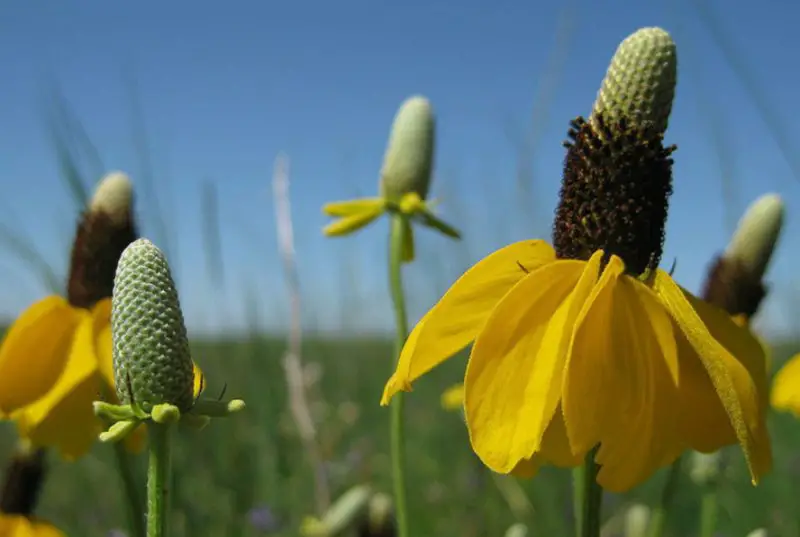
While it also produces varieties with brown or brown-yellow tints, the Upright Prairie Coneflower (Ratibida columnifera) is best known for its yellow blossoms. These unusual flowers are always found at the top of the shrub, above the long green petals. They thrive in grassland environments and like to multiply in places with lots of sunlight and elevation.
Prickly Lettuce
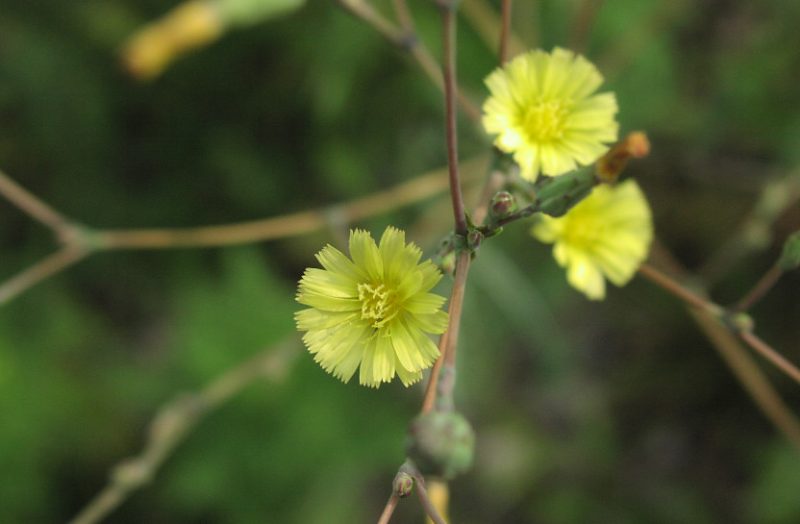
Blooming from mid-summer to September, Prickly Lettuce (Lactuca serriola) is a plant that grows well in temperate areas all over the world and has characteristic pale yellow blooms. It grows tall and has broad leaves. It is edible; historically, people have eaten the leaves and blooms uncooked or cooked. Though it originated in Europe and Africa, it has spread to other areas without becoming invasive.
Common St. John’s-Wort
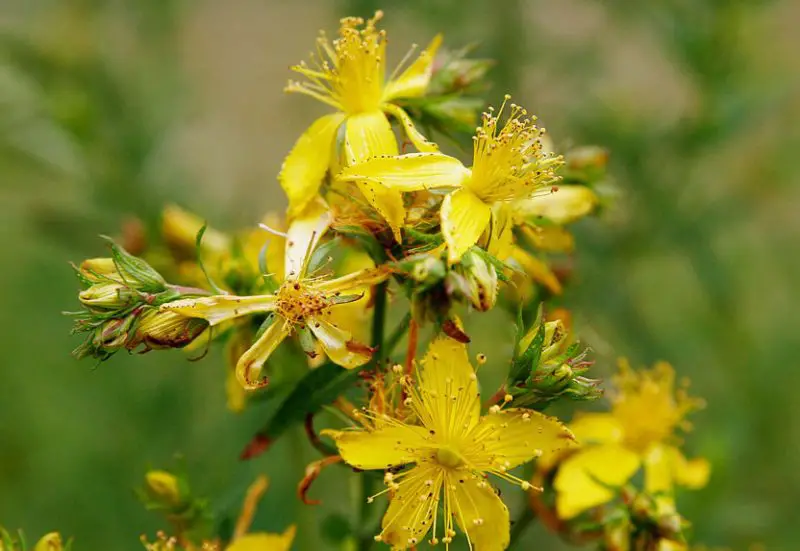
With its many tiny, highly poisonous yellow blossoms, Hypericum perforatum, often known as Common St. John’s Wort, is an infamous invasive weed in North America. It is toxic to people and livestock alike, causing agitation and allergic-like symptoms in animals. Growing as an invasive plant, it is frequently seen in nearby grasslands and prairies, where it thrives in soils that are somewhat humid.
Tall Goldenrod
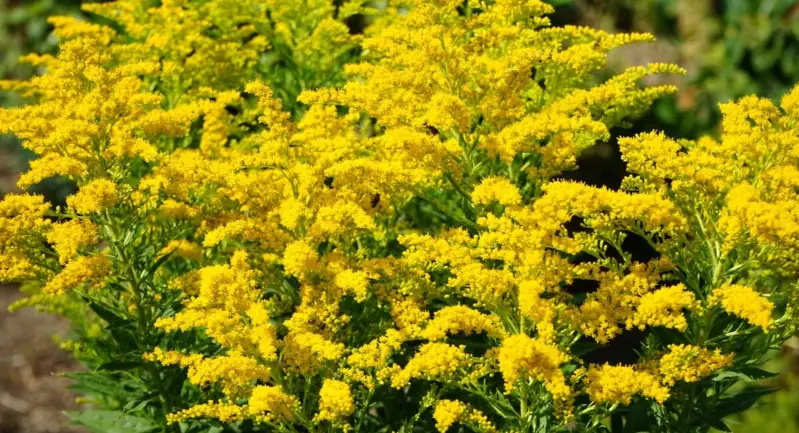
Tall Goldenrod, or Solidago altissima, is a common plant in the US and Canada that is distinguished by its long yellow flowerheads. It is so named because of its enormous height, which ranges from 4 to 6 feet. It’s a popular garden plant and the official flower of states like Nebraska.
Black Medick
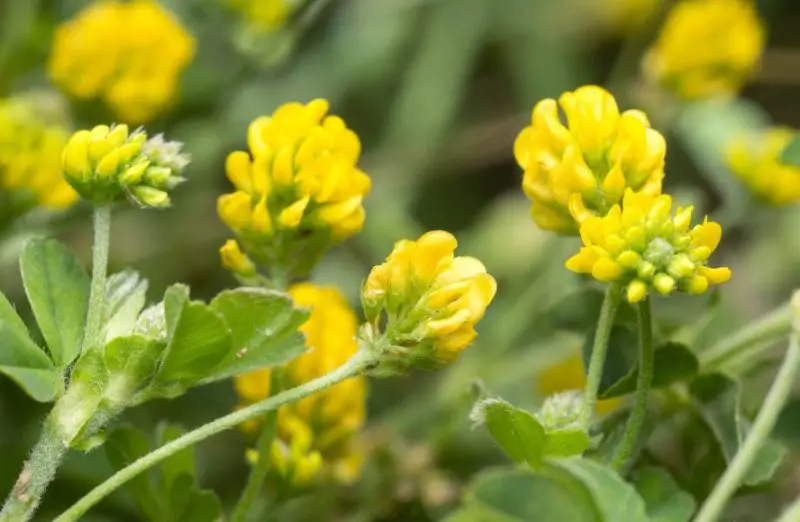
Though not as much as in South America and Europe, black medick (Medicago lupulina) is a common plant in North America. It has many little yellow flowers that are about 3 mm across, and it grows well in a variety of soil types, including prairies. Its blooms are essential for pollinators because they draw bees that produce honey and have a significant impact on the ecosystem.

